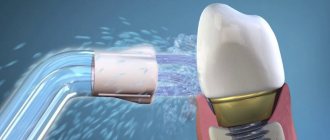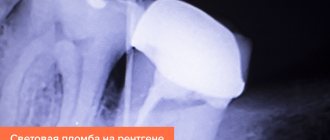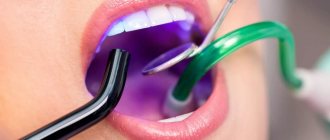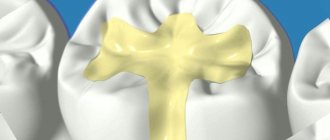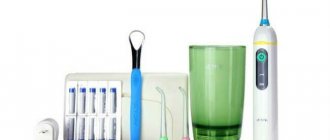- Features of light seals
- When to eat mono after filling?
- What products should you be careful with?
- What complications can there be?
- If the seal falls out or is damaged
In modern dentistry, when reconstructing teeth with composite materials, preference is given to light fillings, which have many advantages over the classic filling composition. A light filling is more convenient to install, less toxic, resistant to heavy loads, looks more natural, and can even match the color of tooth enamel. However, in order to maintain the result achieved by the specialist and not provoke separation of the composite, the recommendations of the attending physician should be followed. One of the main questions that patients ask is when can they eat after a light tooth filling and are there any dietary restrictions in the future.
How much can you not eat after having a filling installed?
All patients are interested in whether they can eat after having a filling installed.
You can eat food, but not immediately after the event, but after some time. Experts use various compositions, and each of them has its own hardening time. But first, you need to consider what you can’t eat after installing a filling in order to avoid its premature destruction.
The list of prohibited products includes all solid products, including chips and crackers, viscous - toffee and other products of similar consistency, coloring - coffee and tea, tomatoes, beets and the like. The consumption of hard and viscous products contributes to the destruction of the filling, and the use of coloring products causes a change in the color of the filling material.
Temporary restrictions
The first question that patients ask the doctor after treatment is: how long can you not eat? It all depends on the technology used, and some of them allow you to eat food almost immediately.
But there is one caveat. Even if the top layer has already hardened, the inner layer is subject to deformation. Therefore, there is no need to rush. There are the following general recommendations on time limits (according to the type of material):
- amalgam – 3 hours;
- plastic – from 3 to 5 hours;
- cement - from 2 to 3 hours;
- photocurable composites – can be eaten immediately;
- chemically cured composites – 1 hour;
- temporary fillings except photopolymer ones – from 2 to 3 hours;
- photopolymer temporary fillings – no restrictions.
How to maintain your treatment guarantee
As a rule, therapeutic treatment, that is, dental filling, is guaranteed from 6 months to 2 years - depending on the volume of work and the complexity of the situation. To maintain the guarantee, the patient must strictly follow all recommendations: do not overload the tooth, do not use it for other purposes (for example, open beer bottles), and also regularly see the doctor in accordance with the individual schedule of medical examinations. Unfortunately, many patients forget about this, and it is the last point that is the key to maintaining the guarantee for treatment.
You need to visit a doctor 1-2 times a year. During a preventive examination, the dentist will be able to make sure that the filling is in good condition and that caries does not develop again underneath it.
Is it possible to drink after having a filling installed?
At the appointment, patients always ask whether they can drink tea or other drinks after treatment. In this case, the same recommendations apply as for eating - it all depends on the technology. But there are also additional restrictions. Drinking drinks is not recommended until the anesthesia effect has completely subsided.
This is due to the possibility of injury to the mucous membrane by too hot a liquid, because sensitivity is reduced. It is very difficult to say exactly how long you can drink. In this case, everything depends on the effectiveness of the painkiller, its duration of action, dosage and individual reaction of the body.
Plastic fillings
The appearance of plastic fillings on the dental market has caused a stir. These fillings quickly became popular, but, unfortunately, this material turned out to be toxic. Plastic also had disadvantages in the form of staining under the influence of drinks and food, and it also quickly lost its shape. 90% of patients subsequently developed pulpitis or periodontitis, an allergic reaction to the material. If a crown was installed on a plastic filling, the tooth underneath was destroyed in a very short time. When this deficiency was discovered, the substance was no longer used, and patients began en masse to replace previously installed fillings. That is why the question of when to eat after installing plastic fillings is not relevant today.
Recommendations
Immediately after installation, you must refrain from drinking and eating for the time recommended by the dentist until the final effect of the pain medication. After this period, you should not eat foods that are too hot or too cold, as they may affect the strength properties of the material.
The load should be moderate. It is advisable to try not to chew on this side of the jaw during the day, since the filling may become loose if it does not harden sufficiently.
In addition to traditional questions about food and drink, dental visitors are also interested in additional questions.
Is it possible to drink alcohol
In fact, alcohol does not have any special effect, which means that theoretically it can be consumed. But the point here is completely different. In most cases, filling is performed under anesthesia, and it and alcohol are incompatible. Therefore, experts recommend abstaining from alcohol for at least a day.
The same can be answered to the question “can I drink beer?” After 24 hours, yes, you can. Beer does not contain coloring enzymes and fillings do not change color under its influence.
Is it possible to smoke after installation?
After the filling procedure, you can smoke approximately 2-3 hours later.
. Tobacco smoke does not affect the color of the filling, unless it concerns plastic-based compounds. They are rarely used due to their fragility, but when using such a composition, smoking immediately after the procedure will cause its darkening. Ideally, dentists recommend giving up cigarettes for at least a day, if possible.
Composite
Today, the physical properties of new filling powders have changed. They are successfully used in cases where deep caries has led to the appearance of large abnormal cavities. Composites fully meet modern standards.
- They have excellent cosmetic and practical characteristics.
- They are suitable for reconstruction of frontal, masticatory units.
- They are installed for children and expectant mothers.
- The material hardens directly in the dentist's office. He exposes the pad to a lamp with ultraviolet rays.
- The substance can be easily given the desired shape.
After the light filling, you can drink water and eat after the sensitivity of the receptors returns. Indeed, with numbness of the lips, tongue, and palate, it is easy to cause mechanical and thermal damage to these areas. Therefore, in this situation, it is advisable to eat no earlier than an hour later, especially if a composition with epoxy resins was used. It is better not to consume drinks and foods such as beets, wine, tea, blueberries, coffee for 24 hours. Also, you should not smoke during the day, as nicotine slows down wound healing. If you follow your doctor's recommendations, this will minimize the risk of the pad falling out or becoming deformed.
What not to do after installation
The main thing that should not be done after installation is to subject the tooth to increased loads.
. Therefore, gnawing any foods (nuts, seeds, candies, etc.) is highly discouraged. Avoid the use of chewing gum, toffees and other similar confectionery products that tend to stick to teeth.
The consumption of hot and cold foods is limited; this can cause the filling material to break prematurely.
There should be no traumatic impact on the tooth, therefore, if discomfort is felt, you should consult a doctor and not take any action yourself.
Is it possible to brush your teeth
A specialist will definitely advise you on how to brush your teeth after installing a filling. It is advisable to do this only the next day. In some cases, it is recommended to change the paste and brush. It is better to choose a brush of medium softness; it will not injure the injection site. Pastes - on the recommendation of a doctor, but without the inclusion of abrasive components.
Recommendations after installing a light seal
Photopolymer is a new material that instantly hardens under the influence of a solar lamp.
Has high strength characteristics. It is possible to select a shade that best matches the natural one. After installation, such a filling is not visible even on the front teeth.
Care
Caring for teeth with polymer fillings is not particularly difficult:
- they need to be cleaned regularly, with a medium-hard brush and gel toothpastes that do not contain abrasive inclusions;
- Dental floss should be used carefully; if it clings to the edge of the filling, you should immediately contact a specialist to eliminate this defect;
- exclude coloring foods from your diet for at least a week;
- limit the consumption of sweets, including sweet carbonated waters, especially those with dyes;
- For several days after the event, do not load the tooth and limit yourself to solid food.
Is it possible to eat after having a light filling installed?
The photopolymer hardens instantly, but the inner layer does not have sufficient strength for some time. Therefore, a reasonable question arises: “when can you eat?”
Although many doctors allow you to eat food immediately after the event, it is better to refrain from eating for a couple of hours. There is a risk of material deformation.
There is also the possibility of staining, so you need to consider what not to eat.
Foods that can stain the filling are completely excluded from the diet for 7 days. These are any drinks with dyes, including strong tea and coffee. Fruits and berries with a likelihood of such an impact (cherries, sweet cherries, mulberries, blackberries, raspberries, black currants and the like). Vegetables such as carrots and beets. It is worth giving up tomato-based ketchups and sauces, tomatoes themselves in any form, and a number of juices. Dentists recommend following a “white” diet during this period. That is, eat only what cannot stain the filling.
Advantages of photopolymer material
This differs from other types of composite materials:
- The ability to control the hardening process. The doctor fills the tooth without haste, applying layers of material as carefully as possible. The composition is plastic, hardens only when exposed to an ultraviolet lamp.
- Safety for the patient's health. Photopolymer material is characterized by low toxicity, so it is used even in pediatric dentistry.
- The ability to create a filling of the desired shade. She won't stand out.
- Durability. It is due to good adhesion to hard tissues. Typically, the service life of a photopolymer filling is at least 5 years. With careful handling and high-quality teeth cleaning, its service life increases.
- Ease of finishing. The composite can be polished well, so the filling does not create discomfort - it will not scratch the mucous membrane of the tongue and cheeks.
An experienced dentist can easily give the crown the desired shape, so the filled tooth looks natural.
After installing a temporary filling
A temporary filling is necessary for multi-stage treatment, which involves access to the cavity after several days or weeks. Therefore, the strength and aesthetic requirements for such materials are low. But in any case, you must adhere to the specialist’s recommendations, otherwise the filling will fall out, pathogenic microbes will enter the cavity and the procedure will have to be repeated.
After installation of a temporary filling, patients are interested in the ability to eat and drink. These points need to be considered.
Is it possible to drink
If a regular cement filling was used, you can drink after 2-3 hours. If the cavity is closed with photopolymer, immediately after installation is completed. But the point here is not about strength, but more about anesthesia. When exposed to it, sensitivity is minimal, so the patient may not feel the temperature of the drink and injure the mucous membrane. Therefore, you need to drink very carefully, avoid too cold or too hot, and it is better to do this after the painkiller has worn off.
Is it possible to eat
The specialist’s answer depends on the material
. The use of a cement filling involves the same restriction as in drinking: from 2 to 3 hours. With photopolymer, it is absent, but it is not recommended to load the tooth until it has completely hardened, so you will have to abstain from hard foods for at least a day.
When can a light seal be placed?
The photopolymer composition is considered universal, therefore it is widely used in dentistry. There are a large number of pathologies for which the dentist prefers this composite, including:
- caries;
- erosion and necrosis of enamel;
- fluorosis;
- wedge-shaped defect;
- pulpitis and periodontitis (light filling is placed at the final stage of disease treatment);
- dental injuries and chipped enamel;
- pathological abrasion of units (a photopolymer filling is installed for temporary restoration of the tubercles).
In addition, the dentist uses this filling material to give the stump the required size and shape before prosthetics with fixed dentures. Thanks to a wide palette of shades and good strength after hardening, the photopolymer composition is suitable for any units in the series; it is also chosen for aesthetic restoration.
Is it possible to experience discomfort after treatment?
After the procedure, slight discomfort is present for 14 days - this is normal.
. During this period, it is necessary to eliminate as much as possible the influence of factors that provoke unpleasant sensations - hot and cold foods, sour, spicy and sweet foods. You also need to avoid excessive stress and carry out hygiene procedures with caution.
But if pain occurs after this period has expired, this is a reason to consult a doctor. There are many reasons for this phenomenon, and only a specialist can accurately identify a specific one.
Types of fillings and care features
Different fillings have their own characteristics in terms of wearing time, hardening, etc. For example, light fillings harden under the influence of a halogen lamp in a matter of seconds, so you can eat or drink water almost immediately after the procedure. However, you should not remove all restrictions: complete hardening of the filling occurs in two days. Composite fillings are very sensitive to alcohol at first, so you should avoid alcohol and alcohol-containing rinses, as the filling may soften.
After treatment, we recommend that you check with your dentist about the type of filling he placed and after what time you can eat.
What to do if your tooth becomes sensitive after installing a filling?
If after installation the tooth reacts to cold or hot, but the required 2 weeks have already passed, you need to urgently go to the dentist. The exception is recently treated pulpitis. In this case, increased sensitivity persists for up to a month.
The specialist will conduct a diagnosis and determine the cause of this phenomenon. This could be the consequences of poor quality filling installation, inflammation or similar diseases. The most common cause of pain is the occurrence of repeated caries. In this case, the destruction of the enamel continues.
If the seal falls out or is damaged
If there is any deformation of the light filling, no action should be taken without first consulting a doctor. If it is not possible to visit the clinic, you can get a consultation by phone. But at the first opportunity, go to the dentist.
If there is a filling, it is important to prevent food particles from entering the tooth cavity. This can lead to inflammation and even the rapid development of a purulent process.
To summarize, we can conclude: eating after filling with photopolymers is acceptable, but with extreme caution. If the patient does not have a strong need for food, it is recommended to eat after 2 hours. Thus, the risks of complications are minimized.
What causes recurrent caries
Repeated carious lesions of tooth tissue can occur due to non-compliance with technology,
which happens rarely, or
the patient’s failure to comply with the doctor’s recommendations – which happens often
.
Due to the shrinkage of the material, which is caused by increased load on the tooth, microcracks appear between the filling and the tissue. They contain pathogenic bacteria. When they multiply, they form an acidic environment. All this contributes to the occurrence of repeated caries, which is hidden under the filling and is diagnosed only after the active development of the pathology. Therefore, it is very important not to violate the doctor’s recommendations. Also, incorrect actions can cause the filling to fall out.
Metal fillings
In the past, metal fillings called amalgam were used in dental treatment for a long period. They were made of copper, gold and silver. Despite their strength and reliability, as soon as alternative options appeared, their popularity disappeared. The amalgam looked unsightly, took a long time to harden, and contained mercury. Patients who received such fillings complained of a metallic taste in the mouth and allergic reactions.
Filling teeth without pain
Nowadays people do not need to be afraid of visiting the dentist, because dental treatment is carried out without pain. High-quality anesthesia is used, and an allergy test is performed first. If the body accepts the drug normally, then the dose is administered in the gum area. After 1-2 minutes the effect appears. A person may notice that the problem area has lost sensation. After this, the doctor can proceed to the procedure itself.
When using anesthesia, a person will not feel pain. You will be able to relax in the dental chair and not worry about anything. This treatment option is the most preferable, because not every patient wants to endure pain.
Some people decide not to use anesthesia. This is because they do not want to administer the medicine or are suffering from an allergic reaction. If the nerve is not affected, the procedure will cause virtually no pain. An experienced specialist will do everything to make the patient feel as comfortable as possible.
Contraindications
In rare cases, filling leads to complications. A person experiences pain even after 3 days from the date of the intervention. Unpleasant sensations can be sharp and shooting, they cannot be eliminated with the help of analgesics. This happens when there is inflammation of adjacent tissues, incomplete removal of the nerve, or poor material. More often, complications are encountered by those people who did not take into account contraindications. In some cases, the procedure cannot be performed, as it can only worsen the situation.
Main contraindications:
- The tooth cannot be restored, so it will have to be removed.
- An x-ray revealed internal root resorption.
- There is severe resorption, which affects more than a third of the root.
- There are carious perforations in the bottom of the chamber.
- Bone loss in which there is loss of periodontal attachment.
- There is a follicular or odontogenic cyst.
The doctor will tell the person whether there are contraindications for the procedure.
Filling services in our clinic
Our clinic in the center of Moscow offers high-quality dental filling services. Experienced dentists with extensive experience approach each client individually and do everything to ensure that the procedure is comfortable. Doctors will choose the type of filling needed after examining the oral cavity. Only high-quality and modern materials are used, which have a long service life.
We perform root fillings without pain or any discomfort. If necessary, we will restore the primary incisors so that they do not further deteriorate and fall out prematurely.
Dentists guarantee a high-quality result - the filling will not differ in appearance from the tooth. It will last for a maximum period, which is determined by the selected material. There are both budget options and expensive ones. The client will be able to choose a specific filling service based on personal needs.
Care after filling - nuances
Brush your teeth regularly
- Plaque accumulates quickly. Use the entire hygienic “arsenal”: brushes, brushes, rinses. This slightly increases the cost, but treating caries is still more expensive.
Be gentle
- modern polymers, although durable, can crack and collapse from regular hard cleaning, and even more so from the use of abrasives like soda.
Visit your doctor every six months
- installing a filling, even the most high-quality and expensive, weakens natural protection. To check whether caries has developed under the structure, come for professional cleaning and do caries prevention.
How is dental filling performed?
Installing a filling is a standard procedure that takes place under local anesthesia. First, the person is given an injection in the gum to numb the problem area. After this, doctors proceed to treat the incisor, and the process lasts on average 15-20 minutes.
Main stages:
- The doctor prepares the enamel and drills out the softened dentin using a drill. The patient does not feel pain because he was given an injection.
- The oral cavity is disinfected using an antiseptic solution.
- A special paste with a healing effect is installed, and a gasket is placed for insulation.
- The walls of the oral cavity are dried using air flow.
- The mass is applied layer by layer for further filling.
- The filling is polished to obtain the required occlusion. The crowns should fit tightly.
- Fluoride varnish is applied for protection and distributed over the surface of the filling.
The procedure is simple and standard, so dentists perform it quickly. The patient only needs to listen to the doctor’s advice to avoid problems. If the filling is installed efficiently, it will last for more than one year. The specific period depends on the selected material, quality, and food preferences of the person. Filling is one of the most effective methods of combating caries and pulpitis. Moreover, the procedure is inexpensive and has a minimum number of contraindications.
How long does the photopolymerization process take?
Hardening of the polymer surface occurs under the influence of an ultraviolet lamp, creating waves with a length of 450 Nm in the blue spectrum.
Primary polymerization occurs during processing, and the filling acquires final hardness and stabilization of chemical bonds within 24 hours . For this reason, the main restrictions are imposed specifically on the day.
